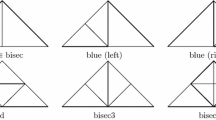Abstract
We investigate a FEM-based numerical scheme approximating extremal functions of the Sobolev inequalities. The main result of this paper shows that if the domain is polygonal and convex in \(\mathbb {R}^2\), then the convergence rate of a finite element solution to an exact extremal function is \(O(h^2)\) in the \(L^2\) norm, and it is O(h) in the \(H^1\) norm, where h denotes the mesh size of a triangulation of the domain.


Similar content being viewed by others
References
Bao, W., Du, Q.: Computing the ground state solution of Bose-Einstein condensates by a normalized gradient flow. SIAM J. Sci. Comput. 25, 1674–1697 (2004)
Bartels, S.: Numerical Methods for Nonlinear Partial Differential Equations. Springer Series in Computational Mathematics 47. Springer, Cham, x+393 pp (2015)
Brenner, S., Scott, L.: The Mathematical Theory of Finite Element Methods., 3rd edn. Texts in Applied Mathematics, 15. Springer, New York, xviii+397 pp (2008)
Cai, Z., Kim, S.: A finite element method using singular functions for the poisson equation: corner singularities. SIAM J. Numer. Anal. 39, 286–299 (2001)
Choi, Y., McKenna, P.: A mountain pass method for the numerical solution of semilinear elliptic problems. Nonlinear Anal. 20, 417–437 (1993)
Choi, W., Hong, Y., Seok, J.: Optimal convergence rate and regularity of nonrelativistic limit for the nonlinear pseudo-relativistic equations. J. Funct. Anal. 274(3), 695–722 (2018)
Faou, E., Jézéquel, T.: Convergence of a normalized gradient algorithm for computing ground states. IMA J. Numer. Anal. 38, 360–376 (2018)
Fromm, S.: Potential space estimates for Green potentials in convex domains. Proc. Amer. Math. Soc. 119(1), 225–233 (1993)
Grisvard, P.: Elliptic Problems in Nonsmooth Domains. Pitman, Boston, MA (1985)
Grüter, M., Widman, K.O.: The Green function for uniformly elliptic equations. Manuscripta Math. 37, 202–342 (1982)
Lin, C.S.: Uniqueness of least energy solutions to a semilinear elliptic equation in \({\mathbb{R}}^2\). Manuscripta Math. 84(1), 13–19 (1994)
Li, Y., Zhou, J.: Algorithms and visualization for solutions of nonlinear elliptic equations. Int. J. Bifur. Chaos Appl. Sci. Eng. 10, 1565–1612 (2000)
Ren, X., Wei, J.: On a two-dimensional elliptic problem with large exponent in nonlinearity. Trans. Am. Math. Soc. 343, 749–763 (1994)
Ren, X., Wei, J.: Single-point condensation and least-energy solutions. Proc. Am. Math. Soc. 124, 111–120 (1996)
Stein, E.M.: Harmonic analysis: real-variable methods, orthogonality, and oscillatory integrals. Princeton Mathematical Series, 43. Monographs in Harmonic Analysis, III. Princeton University Press, Princeton, NJ, (1993)
Tanaka, K., Sekine, K., Mizuguchi, M., Oishi, S.: Sharp numerical inclusion of the best constant for embedding \(H_0^1 (\Omega )\hookrightarrow L^p (\Omega )\) on bounded convex domain. J. Comput. Appl. Math. 311, 306–313 (2017)
Acknowledgements
The authors are very grateful to the anonymous referees for their valuable comments and suggestions. This research of the first author was supported by Basic Science Research Program through the National Research Foundation of Korea (NRF) funded by the Ministry of Education (NRF-2017R1C1B5076348). This research of the second author was supported by Basic Science Research Program through the National Research Foundation of Korea (NRF) funded by the Ministry of Education (NRF-2017R1C1B1008215). This research of the third author was supported by Basic Science Research Program through the National Research Foundation of Korea (NRF) funded by the Ministry of Education (NRF-2017R1D1A1A09000768).
Author information
Authors and Affiliations
Corresponding author
Additional information
Publisher's Note
Springer Nature remains neutral with regard to jurisdictional claims in published maps and institutional affiliations.
Appendix A: Analytic tools
Appendix A: Analytic tools
In the appendix, we arrange the necessary auxiliary tools to handle the analytic issues that arise when we prove our main results.
Proposition A.1
([2, 3]) For any \(u \in H_0^1(\Omega )\), we define \(P_h(u)\) by the \(H_0^1 (\Omega )\)-projection of u onto \(V_h\). In other words, \(P_h(u)\) is a unique element in \(V_h\) that satisfies
Then the following estimates hold:
If \(u \in H_0^1(\Omega ) \cap H^2(\Omega )\) the following estimates hold:
If \(u \in W^{1,q}_0(\Omega )\) for some \(q \ge 2\), the following estimate holds:
for some \(C > 0\) independent of h (refer to [Theorem 8.5.3] in [3]).
Proposition A.2
([9]) Let \(\Omega \subset \mathbb {R}^2\) be a bounded convex domain with a polygonal boundary. For a given \(f \in L^2(\Omega )\), let \(u \in H^1_0(\Omega )\) be a weak solution of the problem
Then u belongs to \(H^2(\Omega )\), and there exists a constant \(C>0\) such that
Proposition A.3
([6, 11]) Let \(\Omega \subset \mathbb {R}^2\) be a bounded convex domain and \(p \in (2, \infty )\). Let U be a minimizer of the problem
satisfying
Then, the following holds:
-
(i)
U is sign definite and unique up to a sign.
-
(ii)
U is non-degenerate. In other words, the linearized equation of (A.1) at U, i.e.,
$$\begin{aligned} \Delta \phi +(p-1)U^{p-2}\phi = 0 \ \text { in } \Omega , \quad \phi \in H^1_0(\Omega ) \end{aligned}$$admits only the trivial solution.
-
(iii)
The following inequality
$$\begin{aligned} \int _{\Omega } |\nabla \phi |^2 - (p-1) U^{p-2} \phi ^2 dx \ge C \int _{\Omega } |\nabla \phi |^2 dx \end{aligned}$$(A.2)holds true for any \(\phi \in H^1_0(\Omega )\) that satisfies \(\langle \phi , U\rangle _{H^1_0(\Omega )} = 0\) and some \(C > 0\) independent of \(\phi \).
Remark A.4
The statements (i) and (ii) are proved in [11]. The statement (iii) is a natural consequence of (ii). We refer to [6] for the rigorous arguments of the proof.
Rights and permissions
About this article
Cite this article
Choi, W., Hong, Y. & Seok, J. Convergence rate of the finite element approximation for extremizers of Sobolev inequalities on 2D convex domains. Calcolo 56, 27 (2019). https://doi.org/10.1007/s10092-019-0326-3
Received:
Accepted:
Published:
DOI: https://doi.org/10.1007/s10092-019-0326-3




